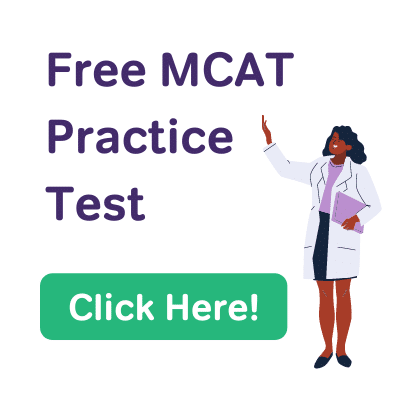
When you’re starting your MCAT prep, the very best place to begin is with an MCAT diagnostic test! Not only will this help familiarize you with MCAT question type variations, but it’ll also give you a sense of the content the exam tests, as well as its difficulty level.
Beyond that, an MCAT diagnostic test is a great way to start your MCAT preparations because it shows you what currently stands between you and your goal score. Don’t get me wrong—there’s a lot of room for growth between MCAT scores on a diagnostic and what you can achieve on test day! But getting a sense of your strengths and weaknesses on a practice exam can help you maximize the former and minimize the latter!
Ready to dive in? Here’s Magoosh’s free MCAT diagnostic test—featuring MCAT practice questions designed by our experts to show you what subject area (or areas) might need your attention before the real exam!
Free MCAT Diagnostic Test

Welcome to the Magoosh MCAT Diagnostic! These questions were created by our MCAT experts to test your knowledge of the MCAT subjects (except CARS questions, which will test your knowledge of how the section works). We recommend taking this quiz before you start your prep!
Should I take an MCAT diagnostic test?
The general answer to this question is: yes, you should take an MCAT diagnostic exam—with some caveats. An MCAT diagnostic test requires a good amount of time and sometimes money as well (though Magoosh has you covered with the free MCAT diagnostic!).
If you’re ready for more practice, sign up to get a FREE full-length MCAT practice test designed by Magoosh MCAT experts. Click the image below to get started!
Besides the free Magoosh MCAT test, I would highly recommend the one put out by the AAMC itself. This full-length practice exam is the gold standard of MCAT practice exams. It costs $35 and provides a simulated score. This is an “official” MCAT diagnostic test and, in my opinion, provides the best indication of what your score range will be.
Note that you can also get a full-length, free MCAT practice test in your official AAMC account, under “MCAT Official Prep Hub.” However, only the previously mentioned AAMC sample test provides you with scaled scoring information.
When to Take an MCAT Diagnostic Test
MCAT diagnostic tests can provide a lot of information. However, unlike full-length MCAT practice tests that you use in MCAT prep, diagnostics are not study tools per se. Instead, they let you know areas of strength and weakness, as well as an estimated score for the real exam. They do not teach you much about how to improve your areas of weakness, and this really requires time and effort on the test-taker’s part.
My advice on how to use an MCAT diagnostic test is to use one at the very beginning of your study time and another at the very end.
Analyzing Your Results and Next Steps
You’ve taken your first MCAT diagnostic test, you’ve gotten your scores—now what?
- Review your answers—both the right answers and wrong answers. Take a look at any patterns that you see, then write them down. Acing biochemistry questions? Struggling with psychology and sociology? Circle any areas that you know you want to work on.
- Next, create a schedule using the information you’ve learned from your MCAT diagnostic test. This can be as simple as noting that on Wednesdays, you study organic chemistry (and wear pink). Or (better option!) you might choose to use one of Magoosh’s MCAT study schedules to cover the content areas you need in an organized, efficient way before test day.
- Then, it’s time to identify the best resources to help you achieve your goals. This can involve anything from taking an online course to working with a tutor, or some combination of methods. And, depending on when you took MCAT-related courses, you can focus on materials for one section, like Chemical and Physical Foundations of Biological Systems, or every section. We definitely recommend at least reviewing the materials you’ll see on all parts of the test. You don’t have to retake General Chemistry if it’s fresh in your mind, but looking at how the MCAT tests this will be important.
- Resource Alert
Try Magoosh’s MCAT Question of the Day and MCAT Sample Questions to get some extra practice!)
From MCAT Diagnostic Test to Full-Length Practice Tests
An MCAT diagnostic test can help lay the groundwork for your prep, but before your actual exam, it’s key to take at least one practice MCAT exam. The earlier you can start doing this, the better.
Trust me: I know it’s really easy to say, “My test isn’t until September; I’ll brush up on my bio and do it later.” But even once you’ve studied everything you need to know about the biochemical foundations of living systems (not to mention the biological foundations of behavior!), you still won’t build the endurance you need for test day until you sit down and put it to the (7.5-hour) test.
You can also check out this list of free MCAT practice tests! The AAMC store also offers the opportunity to bundle full-length exam purchases, as well. If you’re prepping for more than a week or two, we highly recommend getting more than one of these full-length practice tests; the savings can be big. Some bundles include the official guide and question packs that serve as section banks, as well.
As you get closer to your test date, your practice test scores will let you know if you are reaching your target score range. If you are way off from where you want to be, this can perhaps be helpful in a decision to postpone your test date.
- If test day is quickly approaching and you don’t have time for full-length practice tests, the AAMC question packs are a great resource to work on individual sections you’ve flagged in your diagnostic test. Topics include biology, chemistry, physics, a CARS diagnostic, Critical Analysis and Reasoning Skills, and question banks containing mixtures of MCAT sample questions.
Takeaways After Completing Your MCAT Diagnostic Test
Congratulations! By taking this MCAT diagnostic test, you’ve also taken the first step on the road to becoming a physician. While the topics (not to mention the length) of the MCAT can be overwhelming, remember: everything you’re studying today will help your future med student self!
Good luck!







Leave a Reply